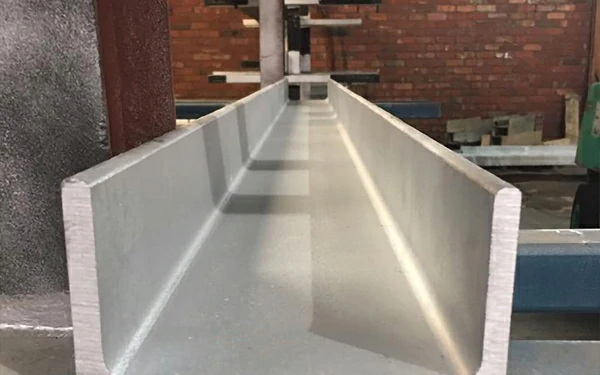Galvanized Channel Steel Comprehensive Analysis
Product Core Characteristics: Hot Dipping Galvanizing Process and Corrosion Prevention Principles
Aug 21,2025

I. Product Core Characteristics: Hot Dipping Galvanizing Process and Corrosion Prevention Principles
Hot-dipped galvanized channel steel, also known as hot-dip zinc-coated channel steel, is a type of profile that achieves long-term corrosion prevention through the hot-dip galvanizing process. Its core process is: after rust removal, the channel steel is immersed in molten zinc at a temperature of 440-460°C, forming a uniform zinc layer on the surface. This zinc layer is tightly bonded to the base material and can physically isolate air, moisture, and other corrosive media, significantly enhancing corrosion resistance - in an ordinary atmospheric environment, a dense oxide zinc film will form on the surface of the zinc layer, and if it further reacts with atmospheric components to form insoluble zinc salts, the corrosion protection effect will be more durable.
Currently, hot-dip galvanizing is the mainstream method for surface corrosion prevention of channel steel, and the thickness of the zinc layer directly determines the corrosion resistance: a thicker pure zinc layer can completely block the contact between the base material and corrosive media, providing long-term protection for the channel steel and ensuring a firm connection with the steel structure, avoiding surface damage.
II. Classification System: Multi-dimensional Division from Process to Material
The classification of channel steel can be distinguished from four dimensions: process, specification, shape, and material. It meets the needs of different scenarios:
According to production process: it is divided into hot-rolled channel steel and cold-formed channel steel. Hot-rolled channel steel is formed by hot rolling of steel billets, with specifications ranging from 50mm to 400mm, having strong load-bearing capacity, and suitable for heavy-duty steel structures; cold-formed channel steel is produced by cold rolling of thin sheet, with high dimensional accuracy and lightweight, suitable for precision equipment and prefabricated buildings.
According to specification differences: it is divided into ordinary channel steel and lightweight channel steel. Both have the same shape, but the waist thickness and leg thickness of lightweight channel steel are thinner, with a lower unit weight, suitable for scenarios with sensitivity to self-weight. The standard specification of hot-rolled ordinary channel steel is 5-40#, and the protocol supply specification is 6.5-30#.
According to cross-sectional shape: cold-formed channel steel is further divided into equilateral, unequal, inner rolled edge, and outer rolled edge types, suitable for complex structural designs.
According to material properties: the basic material is Q235B carbon steel (high cost-effectiveness, meeting general requirements); Q355 low alloy steel (higher yield strength, used for wind turbine towers, high-stress scenarios such as high-speed rail pillars); stainless steel channel steel (outstanding corrosion resistance, suitable for harsh environments such as chemical plants and coastal facilities).
From the perspective of mechanical principles, channel steel should be "used upright" rather than "used horizontally", with wing plates bearing the load to disperse the load and maximize the bending and torsion resistance.
III. Appearance and Fixation: Quality Control and Construction Key Points
1. Appearance Requirements
The surface quality and geometric accuracy of channel steel need to meet standards: the surface must not have harmful defects that affect use, and there should be no significant twisting; wave bends (scythe bends), cross-sectional parameters (h, b, d, t, etc.) must have strict tolerance values. Common geometric defects include corner deformation, leg expansion, leg merging, etc., which need to be strictly avoided in production.
2. Fixation Methods
As a supporting structure, the stability of channel steel fixation directly affects the safety of the project. Common methods include:
Angle steel fixation: divided into welding fixation and bolt connection, precise calculation of dimensions is required to ensure connection strength.
Wall direct fixation: after drilling holes in the wall, the channel steel is inserted, relying on the wall's load-bearing capacity, suitable for thick wall scenarios, with high requirements for wall bearing capacity.
Channel steel mutual support fixation: vertical channel steel is fixed to the wall, considering floor load-bearing capacity, it is advisable to use multi-point distributed support to avoid stress concentration.
IV. Application Areas: Comprehensive Coverage from Traditional to Innovative
Hot-dip galvanized channel steel, with the advantages of "corrosion prevention + high strength", continuously expands its application scenarios:
Traditional fields: construction (glass curtain walls, power towers, scaffolding, water/air transportation pipelines), bridges, transportation, industry (chemical equipment, oil processing, shipbuilding), agriculture (sprinkler irrigation, greenhouses), etc.
Super projects: the artificial island enclosure structure of the Hong Kong-Zhuhai-Macao Bridge uses Q345C channel steel framework, meeting a century-long durability; the roof grid of the National Speed Skating Hall "Ice Ribbon" uses cold-formed channel steel for millimeter-level splicing, suitable for curved design. New Energy Field: The photovoltaic tracking support frame is mainly composed of galvanized channel steel, which can withstand wind vibration and ultraviolet aging; The protective frame for the battery pack of new energy vehicles uses lightweight channel steel to enhance the collision energy absorption performance.
Smart Logistics: The automated vertical warehouse optimizes the single group load-bearing capacity of the channel steel columns to 8 tons; The AGV robot tracks use stainless steel channel steel, with a wear-resistant lifespan exceeding 100,000 hours.
V. Analysis of Advantages and Disadvantages: A Dialectical View of Characteristics and Limitations Advantages
Excellent strength: Outstanding mechanical properties, especially strong in resisting bending and twisting, and high stability of support.
Flexible specifications: A wide range of models, customizable in shape, size, and thickness, suitable for various needs.
Easy to process and install: Lightweight, convenient for cutting, welding, and assembly, suitable for the production of complex components.
Strong corrosion resistance: After undergoing heat galvanizing and other treatments, it can resist rust for a long time and extend service life. Disadvantages
High cost: The production process is complex, especially alloy materials and galvanization increase costs, which are not friendly to low-budget projects.
Insufficient fracture toughness: There may be uneven strength, and it is prone to brittle fracture under low temperature or impact loads.
Easy to accumulate water and dirt: The recessed structure has hidden areas, where rainwater and dust are prone to accumulate. Regular cleaning for corrosion prevention is necessary.
VII. Protective Measures and Comprehensive Evaluation
To address the limitations of channel steel, protective measures are needed to extend its service life:
Aluminum spraying protection: After aluminum spraying, apply anti-corrosion coatings to seal, forming a long-lasting protective layer. It has a strong bond with the steel base and is suitable for large and difficult-to-repair structures. It can be constructed on-site and has significant long-term economic benefits.
Deductive galvanization enhanced protection: In addition to hot-dip galvanization, the hot-blowing galvanization process can further optimize the uniformity of the zinc layer and enhance corrosion resistance by thickening the zinc layer.
Overall, the advantages of channel steel make it a core material in industry and construction. However, its disadvantages can be avoided through reasonable selection (such as choosing weather-resistant steel), optimizing the structure (avoiding water accumulation design), and strengthening protection (galvanizing / aluminum spraying). In practical applications, it is necessary to combine the scenario assessment to balance performance and cost, ensuring long-term stable operation.
NEXT:



